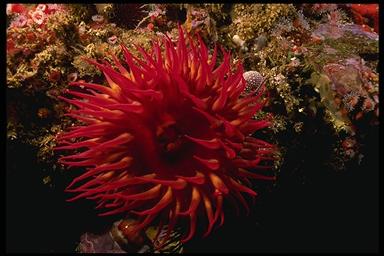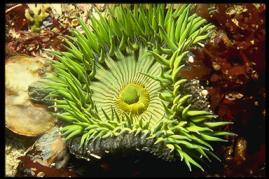Sea Anemones

Sea anemones are colorful marine invertebrates that are found on the ocean floor and are commonly kept in reef tanks.
The reason anemones are often so colorful is because many sea anemones contain zooxanthellae just as corals do. Zooxanthellae are a type of algae and it is the pigments produced by the algae that gives color to many corals and sea anemones.
Zooxanthellae produce food through photosynthesis in response to light and the anemones that contain this algae obtain nutrients in this way. Anemones that obtain most of their nutrients through their relationship with zooxanthellae algae must have the proper lighting for a reef tank or they won't survive.
In addition to the food that zooxanthellae containing anemones obtain through photosynthesis, they also possess nematocysts, which are stinging tentacles used to obtain food (e.g., fish, crustaceans).

Anemones will use their nematocysts to sting fish, releasing poison into the fish's body. Anemones may also use their nematocysts to sting aquarist's hands that get too close to them. Anemone stings are painful. Anemones sometimes use their stinging tentacles to catch and kill fish and other invertebrates in the tank.
A good water flow in the aquarium is important for sending food to anemones. Even anemones that obtain most of their nutrients through zooxanthellae photosynthesis should be fed a couple times a week. Those anemone species that don't contain zooxanthellae would of course need to be fed more often.
Sea anemones have an opening at their center that serves as the mouth, and this opening is connected to their stomach.
Sea anemones are carnivores, but do not have to be fed live fish. It is actually cruel to use feeding sticks to place living fish into the anemone's reach. Anemones can be fed small pieces of (non-living) chopped up shrimp and other seafood and meaty aquarium fare for marine fish.
Anemones usually attach themselves to rocks or the substrate in the aquarium. They mostly remain in the same location, but can move themselves if they find their location unsuitable.
Depending on the species, sea anemones reproduce through sexual or asexual reproduction. Asexual reproduction of anemones takes place by lateral fission or budding. What this means is that the sea anemone splits itself into two different anemones.
Sexual reproduction takes place by anemone species that release sperm and eggs. Many anemones are hermaphroditic - possessing both sperm and eggs within the same individual. During anemone spawning, eggs and sperm are released through the mouth into the water. The eggs and sperm combine and produce free-swimming larva.
Although sea anemones can be lethal to lots of fish, some fish have a symbiotic relationship with them. For example, clownfish often hide among anemones of the Heteractis spp. and don't get stung. Clownfish produce mucous on their bodies that prevent the anemones from stinging them. Because most fish can't get near anemones without being stung and eaten, the clownfish is protected from predators. It isn't quite as obvious what benefit the anemone gets from its relationship with the clownfish, but it is thought that the clownfish helps to fan the water flow around it.
Watch the You Tube video below of the anemone's symbiotic relationship with the clownfish.
